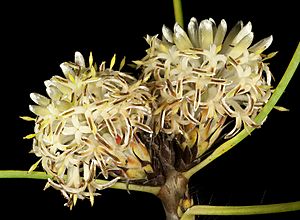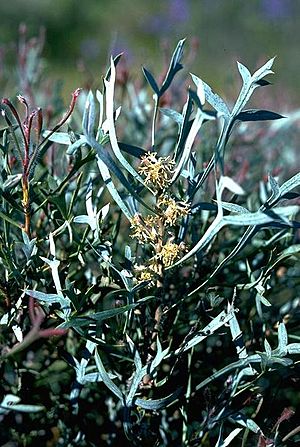Petrophile glauca facts for kids
Quick facts for kids Petrophile glauca |
|
|---|---|
 |
|
| Scientific classification | |
| Genus: |
Petrophile
|
| Species: |
glauca
|

Petrophile glauca is a special kind of flowering plant that grows only in the southwestern part of Western Australia. It's a shrub, which means it's a woody plant smaller than a tree. This plant is known for its unique leaves that are flattened and have a bluish-grey look, like they're covered in a fine powder. It also has pretty yellow to creamy-white flowers that grow in round clusters.
What Does It Look Like?
Petrophile glauca is usually a shrub that grows about 0.5 m (1 ft 8 in) to 1 m (3 ft 3 in) tall. That's about half to a full meter, or roughly knee-high to waist-high for a grown-up. Its younger branches and leaves are mostly smooth, without much hair.
The leaves are very interesting! They have a bluish-grey color, which is what "glaucous" means. They are flat and can be quite long, from 70 mm (2.8 in) to 195 mm (7.7 in) (about the length of your hand or a bit longer). Each leaf is divided into many smaller parts, like a feather, all the way to the middle. These smaller parts are called pinnae, and there are usually seven to twelve of them, each about 25 mm (0.98 in) long.
The flowers grow in round clusters, almost like little balls, about 14 mm (0.55 in) across. You'll find these clusters where the leaves meet the stem, or at the ends of the branches. At the bottom of each flower cluster are small, overlapping, triangle-shaped leaves called bracts. The flowers themselves are about 14 mm (0.55 in) long, yellow to creamy-white, and feel a bit hairy.
This plant usually blooms from August to November. After the flowers, it produces small, hard fruits called nuts. These nuts are joined together in an oval or round head, about 15 mm (0.59 in) wide.
Its Name and Discovery
The plant Petrophile glauca was officially named in 1995 by a scientist named Donald Bruce Foreman. He described it in a big book series called Flora of Australia. The plant material he used to describe it was collected by Neville Graeme Marchant in 1979.
The second part of its name, glauca, is a Latin word. It means "having a bluish-grey bloom," which perfectly describes the color of its leaves!
Where It Lives
This petrophile plant grows in different kinds of places, usually in sandy or gravelly soil. You can find it in southwestern Western Australia, in an area stretching between towns like Wagin, Lake King, and Corrigin. It also grows in places like the Frank Hann National Park and near East Mount Barren.
These areas are part of different natural regions in Western Australia, including the Avon Wheatbelt, Coolgardie, Esperance Plains, and Mallee regions.
Is It Safe?
The good news is that Petrophile glauca is considered "not threatened" by the Western Australian Government's Department of Parks and Wildlife. This means that, for now, there are enough of these plants in the wild, and they are not at risk of disappearing.

